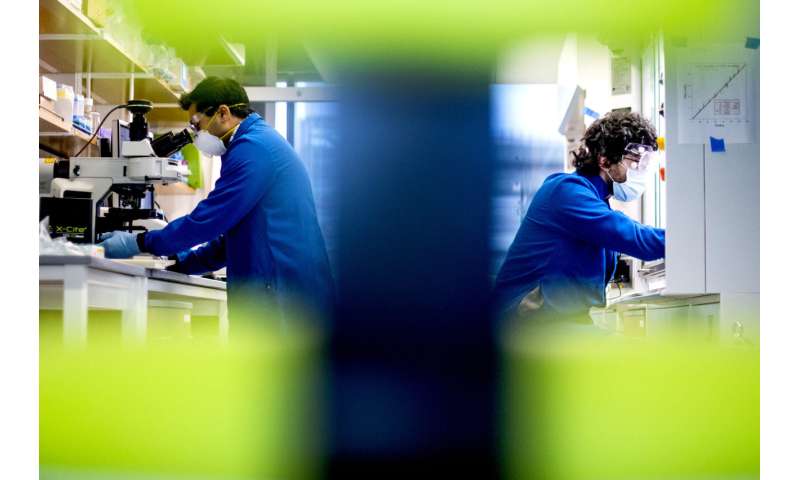

If you are reading this in the United States, you’re probably dwelling on the great mask debate—not about whether to mask on (definitely do it), but instead about how to make a mask that works.
But first things first: simple cloth masks will help get the job done of minimizing the spread of viral particles coming out of someone’s airway, even if that person is asymptomatic.
New scientific evidence suggests, for example, that the spread of the virus could be substantially controlled if everyone wore a mask when in close contact with other people.
But as the pandemic rages on, people are asking more of their masks.
And the research is also mounting about how some homemade masks can also help stop viral particles from entering someone’s airway.
Northeastern researchers have contributed to that body of evidence with tests to examine the filtration capabilities of different sets of masks, including homemade and commercially available options.
Layers, layers
When choosing which materials to use to provide some protection, important aspects to consider include not only the materials you use to make it, but the number of layers you use.
Recent findings by Steve Lustig, an associate professor of chemical engineering, suggest that different combinations of common fabric can be as effective at stopping coronavirus particles from passing through as the materials of N95 respirators, the masks approved by the U.S. government to help prevent medical staff from inhaling the coronavirus and other harmful pathogens in the air.
Lustig set up a team to study more than 70 combinations of common fabric. Their findings show that one of the most important aspects to make homemade masks that offer some protection to prevent inhaling the virus is to have enough fibers within the materials, which can in turn offer higher chances of trapping viral particles.
Independently, most common fabrics won’t be able to stop tiny particles such as the SARS-CoV-2 coronavirus that causes COVID-19. But by creating a less direct pathway that a viral particle has to travel before reaching the nose and mouth, masks made with more than one layer of fabric can help provide different levels of protection. The mask that Lustig wears, for example, consists of a pair of terry cloth layers.
The other key aspect in making masks that offer better protection to the wearer is using at least one water-repellent layer to help prevent aqueous substances such as respiratory droplets from passing through a mask. That’s because wet layers of fabric can make it easier for viral particles to wick through a mask and reach the wearer’s face.
Lustig’s tests show that good layers to block coronavirus particles include combinations of terry cloth, quilting cotton, and flannel. Add to that a water-repellent fabric, and you could have layer combinations that, together, make for protection that is as efficient or better as the material in N95 respirators.
Some water-repellent layers include nonwoven polypropylene, such as OLY-Fun fabric, as well as materials consisting of polyester and polyaramid, a blend found in the fabric that’s used to make lab coats.
Also, one way you can easily turn normal fabric into a water-repelling barrier is spraying it with fabric protectors such as Scotchgard on the outer or middle layers of a mask—not the layer directly touching the face, Lustig says.
“With many kinds of cotton, one or two layers won’t work,” he says. “But multiple layers will be effective, and if you at least have one or two layers that are hydrophobic, you’re going to get pretty good protection.”
A snug fit
Not all masks are created equal, and neither are people’s faces. That means that even if you combine the best available materials to make a homemade mask, the thing might not offer enough protection from the coronavirus and other harmful microscopic particles if it doesn’t create a tight seal on your face.
That’s exactly why Loretta Fernandez, an associate professor of civil and environmental engineering, set out to test different masks from people who started making masks to address shortages in the U.S. in April.
The tests, which included Amy Mueller, an assistant professor of civil and environmental engineering, also focused on testing masks made with materials commonly available at home or from fabrics commonly sold by crafts and fabric retailers.
The team found that one trick to improve the fit of any of those masks is adding a layer of nylon to help press the mask closer to the face. In their tests, the team simply used pantyhose cutouts.
The basis for using nylon to create a better fit on the face is that with a tighter seal, microscopic viral particles won’t pass through the gaps and openings you would normally get from a mask that fits poorly on your face.
Instead, as you breathe in, the particles will be pulled onto your mask, which can help filter them out.
Still, Fernandez says, everyone should consider that there isn’t an absolute, one-size-fits-all approach to making homemade masks.
There are instances, for example, in which a nylon layer could reduce the filtration capability of certain masks. Those masks include homemade masks mainly consisting of bulky materials, Fernandez says.
Source: Read Full Article